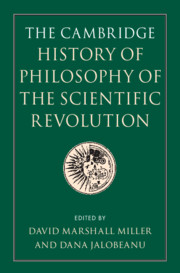Book contents
- The Cambridge History of Philosophy of the Scientific Revolution
- The Cambridge History of Philosophy of the Scientific Revolution
- Copyright page
- Contents
- Tables and Figures
- Contributors
- Preface
- Introduction The Disciplinary Revolutions of Early Modern Philosophy and Science
- Part I The Disciplines
- Part II Disciplinary Activities
- 8 The Art of Thinking
- 9 Astrology, Natural Magic, and the Scientific Revolution
- 10 Practitioners’ Knowledge
- 11 Medicine and the Science of the Living Body
- 12 Experimental Natural History
- 13 Celestial Physics
- 14 Applying Mathematics to Nature
- 15 Mathematical Innovation and Tradition: The Cartesian Common and the Leibnizian New Analyses
- 16 Mechanics in Newton’s Wake
- Part III Problems and Controversies
- Bibliography
- Index
15 - Mathematical Innovation and Tradition: The Cartesian Common and the Leibnizian New Analyses
from Part II - Disciplinary Activities
Published online by Cambridge University Press: 14 January 2022
- The Cambridge History of Philosophy of the Scientific Revolution
- The Cambridge History of Philosophy of the Scientific Revolution
- Copyright page
- Contents
- Tables and Figures
- Contributors
- Preface
- Introduction The Disciplinary Revolutions of Early Modern Philosophy and Science
- Part I The Disciplines
- Part II Disciplinary Activities
- 8 The Art of Thinking
- 9 Astrology, Natural Magic, and the Scientific Revolution
- 10 Practitioners’ Knowledge
- 11 Medicine and the Science of the Living Body
- 12 Experimental Natural History
- 13 Celestial Physics
- 14 Applying Mathematics to Nature
- 15 Mathematical Innovation and Tradition: The Cartesian Common and the Leibnizian New Analyses
- 16 Mechanics in Newton’s Wake
- Part III Problems and Controversies
- Bibliography
- Index
Summary
During the seventeenth century, the advent of what were known as the “common” and “new” analyses fundamentally changed the landscape of European mathematics. The widely accepted narrative is that these analyses, analytic geometry and calculus (mostly due to Descartes and Leibniz, respectively), occasioned a transition from geometrical to symbolic methods. In dealing with the science of motion, mathematicians abandoned the language of proportion theory, as found in the works of Galileo, Huygens, and Newton, and began employing the Newtonian and Leibnizian calculi when differential and fluxional equations first appeared in the 1690s. This was the advent of a more abstract way of practicing mathematics, which culminated with the algebraic approach to calculus and mechanics promoted by Euler and Lagrange in the eighteenth century. In this chapter, it is shown that geometrical interpretations and mechanical constructions still played a crucial role in the methods of Descartes, Leibniz, and their immediate followers. This is revealed by the manner in which they handled equations and how they sought their solutions. The passage from proportions to equations did not occur in a single step; it was a process that took a century to reach completion.
Keywords
- Type
- Chapter
- Information
- The Cambridge History of Philosophy of the Scientific Revolution , pp. 274 - 292Publisher: Cambridge University PressPrint publication year: 2022

